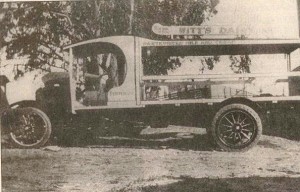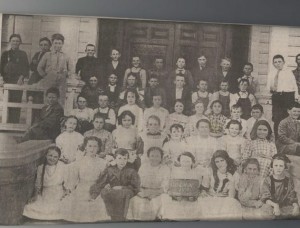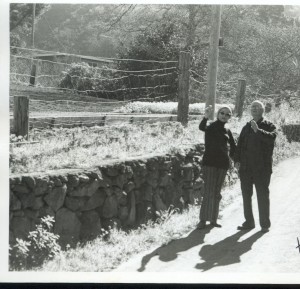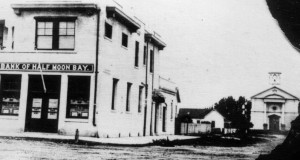Yep, from the pound. Thanks Katie.


Created by June Morrall
Yep, from the pound. Thanks Katie.

 The Captain Morgan Rum commercials have been all over tv, so it’s likely you’ve seen one of the off-beat “Got a little Captain in you?” ads.
The Captain Morgan Rum commercials have been all over tv, so it’s likely you’ve seen one of the off-beat “Got a little Captain in you?” ads.
The “Got a little Captain in you?” refers to people after they drink the rum. They drink Captain Morgan because it’s different as they are. And, we learn from the commercial that Captain Morgan Rum IS very different, because, well, when you take a sip while standing up, ONE of your legs may suddenly rise and bend at the knee, signaling that you’ve got a little of “Captain” in you.
When you see a row of people with a “little Captain” in them, it’s quite effective. And from the beginning, I wondered if there was any basis in fact to having a “little “Captain” in anyone.
I found the answer in the book, Discovery of France ,by Graham Robb, in the unnumbered picture section, between pages 142-43. The caption describes the 1905 photo as a staged scene in the spa town of La Bourboule. The image shows country folk performing a dance called the bourree—and it certainly looks like they have a “little Captain” in them.
 [Image: The Witt Dairy was located in Colma.]
[Image: The Witt Dairy was located in Colma.]
After the death of 97-year-old Evelyn LaFrance Witt in Menlo Park nine years ago, Wendy Witt discovered two dusty suitcases in her grandmother’s closet. They were bursting with old photos, yellowed newspaper clippings, letters and documents, the raw material of her family history.
A UC Berkeley and University of Santa Clara graduate, Wendy Witt is an attractive 44-year-old attorney, who practices family and some criminal law at her San Jose firm: Witt & Reyes.
Wendy meticulously sifted through her treasure, bringing the collection to life.
“I was looking for my grandmother’s recipes,” Wendy says. “She was a good cook and made great ravioli.”
Wendy explained that although her grandmother’s parents were French, she learned the art of Italian cooking from “tons of Italian friends” in Colma where she grew up.
Wendy had a fuzzy portrait of her grandfather, Albert Witt, Colma dairyman and county supervisor. She was 5-years-old when Witt died in 1969. But as she studied the old photos and documents, a clearer image emerged of the grandfather she fondly remembered carrying her around as he watered the garden at his Menlo Park home.
The story of the Witt family began in Colma where dairies and farms once dominated the rural landscape.
In the 1880s, when he was 10, Albert Witt’s father, also called Albert, traveled from Germany to California immediately settling in Colma, where friends of the family already resided.
Albert, Sr. toiled on nearby farms, was frugal, and soon purchased a lucrative milk delivery route. Success followed, and after the 1906 earthquake and fire, he founded the Witt Dairy Company. Producers of milk, butter and ice cream, the Witt Dairy was located between East Market and Chester Streets where Colma Elementary stands today.

Al, Sr. had long been married to Elise Faulkman, and in 1900, blond, blue-eyed Albert, Jr. was born. When he wasn’t at school, the little boy helped with chores on the Colma dairy farm.
At the onset of Prohibition when his father expanded interests to Half Moon Bay, the now 19-year-old Albert, Jr. had familiarized himself with all aspects of the dairy operation.
“My grandfather loved the Colma-Coastside area,” said Wendy Witt. “He knew every inch of it and the name of every ranch owner.” These connections surely helped him later with his political career.
In the 1920s he married 26-year-old Evelyn LaFrance, also a Colma resident.
The most interesting piece of correspondence Wendy uncovered was evidence that may have accounted for her grandfather’s entrance into county politics. She believes the turning point came when the Witt Dairy Company opposed a tax imposed on San Mateo County dairies delivering milk to San Francisco. Letters reveal some details of a legal case concerning milk inspection procedures and taxes on out-of-county milk deliveries.
The Witt family obviously believed getting involved in politics was the best way to protect their dairy interests.
“My great-grandfather put up the money for Al to run for county supervisor,” Wendy recalled.
On the plus side, Al Witt, Jr., a Republican candidate, revealed himself as intelligent and good-looking, with a warm, friendly smile. On the minus side, he might not have been “the most diplomatic person,” admits Wendy Witt. “Maybe he was too direct, but remember he wasn’t a career politician.”
As the population approached 100,000, San Mateo County found itself in transition from a rural area to an industrial center. Al Witt, Jr. best reflected this change. On the one hand, he was a successful dairy farmer, and now as a citizen-politician was getting involved with “brass knuckle” local politics.
Al Witt, Jr. was 32 when he asked voters from the First District, including Colma and Daly City, to elect him in 1932. At that time supervisors were still chosen by voters from their district, a practice soon to change to elections-at-large.
Voters liked Al Witt, Jr., electing him with a great majority. As one of the youngest candidates to ever win a seat, he joined a board comprised of older, seasoned politicians.
Witt chose a tumultuous time to enter politics. The bull stock market of the 1920s had collapsed. The federal government had initiated the Work Projects Administration (WPA), but they needed the cooperation of local politicians to implement the programs and get people to work.
But there was another insidious force in the county. Maybe it was the vestige of Prohibition or the county’s earlier sordid history as the “legal” playground for activities outlawed in San Francisco.
———-
Gambling was of great concern to many. Bookmaking and slot machines were no longer confined to specific areas in the county, and the political machine supporting them was growing more powerful.
Before Al Witt, Jr. took office, a grand jury reviewing criminal activity had issued a scathing report directing officials to shut down gambling houses. When Witt began attending board meetings in Redwood City, a second report was issued, criticizing officials for not doing their job. The gambling houses continued to bustle with activity, and the men behind the political machine attempted to stifle the reformers.
Pointing to the board of supervisors, the jury report cited lack of harmony among members, charging that “existing internal strife and political alignment within the board of supervisors had done much to retard the county’s progress.”
Board meetings were contentious affairs with alliances formed, severed and reformed. Supervisor Rosalie Brown was singled out for not submitting official invoices for work performed by the road master. She paid him with cash from the county treasurer. She explained this was the way things had always been done.
Half Moon Bay Supervisor Manuel Francis was found to have “purchased tires for his former county car without the formality of first obtaining requisitions from the county purchasing agent.”
New Supervisor Al Witt, Jr. wasted little time adapting to the board’s contentious climate, and suffered his share of criticism. The jury report cited the weekly confrontations between Supervisor Witt and the county engineer, a fellow he deemed incompetent and wanted to replace. The jury also accused Witt of “hiring trucks in an amount of $1,100, when authorized to spend only $500, disregarding proper procedure.”
Just as he quickly became entangled with the board’s controversies, Supervisor Witt became identified with positive county programs. He visited Washington, D.C. to get WPA money for local projects, and earned favorable press coverage for Half Moon Bay artichokes by bringing a crate of the thorny vegetables to Mayor LaGuardia in New York.
In December 1935, for example, many WPA activities were completed, including culverts, sewers and roads at Memorial Park, Miramar, Woodside, Jefferson Avenue, San Francisquito Creek, Belmont, 39th Avenue, Brisbane, Salada Beach and many other locations.
Supervisor Witt was most proud of the county’s park and beach acquisition project.
Before he took office, the County purchased 310 acres of redwood forest on Pescadero Creek for what would become Memorial Park. As supervisor, he helped further develop Memorial Park and was gratified when funds were set aside for the purchase of more than three miles of ocean beach lands.
“He loved the Coastside and the beaches,” said Wendy Witt, referring to her beloved grandfather. “He was interested in preserving them with full public access.”
The most outstanding acquisition, wrote Supervisor Witt in the California Beaches Association Monthly Bulletin, was the purchase of some 50 acres south of the San Mateo-San Francisco county line, through which the first leg of the San Francisco to Santa Cruz highway had been completed. This 50-acre park site encompassed the Mussel Rock area.
Witt announced he would run for a second term, aligning himself with Half Moon Bay’s Supervisor Francis, who had long served on the board. But the rules had changed. For the first time, supervisors would be elected-at-large with winners determined by total county votes rather than district-by-district. Although Supervisor Witt
[more coming]

I like this book by Brian Hayes.

The information about power (electrical) grids is enlightening; I had no idea the country was divided into a number of power grids. The West and East have their own. A small part of Texas has its own. Fly-over country has its own. A future plan is to unite them all into one powerful (electrical) grid.

From Barry Parr at Coastsider.com
San Mateo County Supervisor Rich Gordon is planning to attend Wednesday’s
Midcoast Community Council meeting. Coastsider wrote last week about
Supervisor Gordon’s proposal to limit who we can elect to the Midcoast
Community Council.
If you’re interested in how the Midcoast is governed by the county, you
should attend this meeting. If you have opinion about how we should govern
ourselves, you should plan to speak.
The meeting is at 7:30pm and this item will be discussed about ten minutes
after the meeting starts.
Unless we can get the Supervisors to hold a real meeting on the Midcoast,
this will be your only opportunity to speak at a convenient time and place.
The Supervisors will be discussing this proposal during the day on Tuesday,
Jan 27, in Redwood City.
The meeting will be held at Seton Medical Center Coastside: Marine
Boulevard & Etheldore, Moss Beach. Take Highway 1 to Marine Boulevard and
follow hospital signs uphill. Attendees must park in upper parking lots per
hospital policy. Turn left just before the end of the main driveway.
WHY THIS MATTERS
If you haven’t caught up on the issue, here are three items worth reading,
including a must-watch video of Supervisor Gordon’s legislative aide laying
down the law for our elected representatives:
http://coastsider.com/index.php/site/news/the_supervisors_must_stop_treating_the_midcoast_like_a_colony/
http://coastsider.com/index.php/site/news/video_supervisors_legislative_aide_lowers_the_boom_on_mcc_over_letter_to_la/
http://coastsider.com/index.php/site/news/coastside_democrats_ask_supervisor_gordon_to_bring_his_mcc_proposal_to_the_/
I also want to thank New Leaf for choosing Half Moon Bay as the location of their first market outside of Santa Cruz. I can’t tell you what a difference it has made for us, having New Leaf here in town. If you haven’t been there yet, New Leaf specializes in organic foods and there’s plenty of local fresh produce to choose from. And there’s a discount for seniors.
[vimeo]http://vimeo.com/1167543[/vimeo]

From: History of San Mateo (narrative & biographical) by Frank Stanger (1938)
John L. Debenedetti
No citizen of San Mateo County has given more intensive and unselfish effort to the promotion of the prosperity and welfare of the community than has John L. Debenedetti, who as general manager of the Half Moon Bay Artichoke Association has achieved most noteworthy results. He is a native of the locality in which his interests are centered, having been born at Half Moon Bay, San Mateo County, on the 14th of January, 1880, a son of Joseph and Teresa (Scarpa) Debenedetti, who are represented elsewhere in this work.
John L. Debenedetti received his educational training in the public schools of Half Moon Bay and in Santa Clara College, after which he took a position in the business office of the San Francisco Call, where he remained two years. He subsequently engaged in mercantile pursuits, conducting general merchandise stores at South San Francisco and at San Bruno, for eight years, when he sold out to his brother, in order to take over the management of his father’s estate, incorporated under the name of the Joseph Debenedetti Company as well as the management of the estate of of the Misses Cuneo and Mrs. Debenedetti estate. While managing these extensive interests he became connected with the Bank of Half Moon Bay, as vice president, and soon became president of the bank, which he later sold in order to devote his entire time and attention to the development of the artichoke business, which in this locality had been neglected, as well as to give his personal attention to the management of the aforementioned estates. He became the chief organizer of the Half Moon Bay Artichoke Association, of which he was manager in 1916, and from that time on has been a hard and persistent worker in his efforts to introduce the artichoke into the markets of the country, principally in the east.
He has been eminently successful and has been the means of promoting the growing of this vegetable in Santa Cruz and Monterey counties. Mr. Debenedetti pioneered the Santa Cruz fields. On account of the increased eastern demand for this vegetable he later extended his activities to the Salinas Valley of Monterey county and today is the leading spirit in the industry, which has become one of great importance.
The Half Moon Bay Artichoke Grower’s Association is a cooperative organization of growers. They have branch sales organizations in the largest cities throughout the United States and maintain headquarters in San Francisco. Mr. Debenedetti is still devoting himself untiringly to its interests. In this connection also he has been very much interested in the welfare of the Italian immigrants who have located in this section of the country and many of whom, through his efforts and influence, have become prosperous and contented citizens of their adopted land. His splendid work in this regard was recognized by the Italian government, which expressed its appreciation by conferring on him the Chevalier Cross, a highly prized honor.
Mr. Debenedetti was united in marriage to Miss Rose F. Cuneo, who was born and reared in San Francisco and whose father was a prominent capitalist and philanthropist of that city. To Mr. and Mrs. Debenedetti have been born four children, as follows: John L., Jr., Rose Marie, Loraine and Joan. Politically Mr. Debenedetti gives his support to the democratic party and is a member of the Benovolent and Protective Order of Elks. The only public office held by him was that of county tax collector, to which he was appointed on giving up his stores, but he has no taste for politics, and has never consented to accept other offices , his chief interests being his business and his home. Unostentatious in manner, he is nevertheless a man of strong character and agreeable personality, and commands the confidence and esteem of the people generally, who recognize and appreciate the service he has rendered to his community.
———-

From a published biography (I don’t have the year) of Judge Manuel Jesse Bettencourt
Judge Manuel J. Bettencourt was born at Half Moon Bay, and he has capably filled the office of Justice of the Peace there of the Fourth Township since 1930, and was just re-elected to the office on November 8, 1938, for another four -year term.
Judge Bettencourt was born on February 11, 1886, son of John and Mary (Machado) Bettencourt. His father, who is deceased, was born on the Island of St. George, one of the Azores group. His mother is still living at an advanced age in San Jose.
Judge Bettencourt was educated in the schools of San Benito County and in Santa Clara County, his parents having moved to Mountain View in the latter county in 1902. In 1904 he went to work for the J.S. Belchor Company, dealers in feed and fuel, and continued for about a year in this connection, and then joined the Levy Brothers Department Store, where he remained one year, following which he entered the employ of the San Mateo Feed and Fuel Company.
In 1911 Judge Bettencourt became manager of the Bank of Half Moon Bay, which in 1927 was sold to the Bank of America, and he continued on as manager until 1930.
Prominent in fraternal and other organizations, Judge Bettencourt has been a member of Ocean View Lodge of OddFellows of Half Moon Bay for the past twenty-seven years, and for the same length of time has been affiliated with the Seaside Parlor of Native Sons. He is a member and officer of the U.P.E.C. and the I.D.E.S., Portuguese fraternal lodges.
He married Irene de Bennedeti, who was also born in Half Moon Bay.
Judge Bettencourt is rated as one of the most prominent and influentical citizens on the coast side of the county. Long active in civic and community affairs, he is held in the highest esteem by his fellow citizens, and his election to the post of Justice of the Peace on three successive occasions is concrete evidence of his popularity.
———–
I did not meet “the Judge,” as the locals called him; he passed away before I came her– but I was very lucky to talk with his wife, Irene, on several occasions. Irene was the most active 90-year-old in town. Nothing could stop her–she loved driving her bright yellow VW “bug” around Half Moon Bay as much as she enjoyed relaxing in the afternoon with a cocktail.
We called her Irene, not Mrs. Bettencourt. I wish I could describe how she wore her hair because it just completed her elegant “look.” Irene Bettencourt lived in the home her husband, “the Judge” built about 1915 on Johnston Street, still home to many oldtimers. I recall Irene telling me that, when built, their home was on the outskirts of Half Moon Bay!
When Irene Debenedetti and Manuel Bettencourt wed, observers noted the marriage was a kind of “merger”, a marriage joining Half Moon Bay’s Italian and Portuguese community.
When she was 99, Irene Bettencourt gave up driving, and maybe her afternoon cocktail, too. She told friends that she was finally tired. Irene Bettencourt passed away in Half Moon Bay at age 100 in 1990.
—————–
Judge Manuel J. Bettencourt passed away in June 1969.
Services will be held in Half Moon Bay Wednesday for Manuel Jesse Bettencourt, a well known real estate and insurance broker, a former banker, and a past Justice of the Peace.
Mr. Bettencourt died in his Half Moon Bay office of a stroke. He was 83.
A native of Half Moon Bay, Mr. Bettencourt was president of the Bank of Half Moon Bay from 1912 to 1928. In 1926 he sold his interest in the bank to the Bank of America but stayed on for two years as manager. From 1928 to 1950 [ed. Including the years of Prohibition and WW II] he was a Justice of the Peace, and until two years ago owned a lumber yard [ed. This would be Half Moon Bay Lumber, which was located on the Main Street side of the Bettencourt home.]
————–
[Note: I wish I had a photo of the Bettencourts together.]